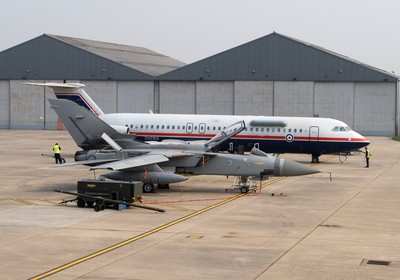One Pilot... Five Aircraft
A system which provides a single pilot with the ability to fly
their own aircraft... while simultaneously directing up to four
further unmanned aircraft has been successfully demonstrated from
the cockpit of a military jet for the first time. The system,
developed by QinetiQ and funded by the UK Ministry of Defense
(MoD), gives unmanned aircraft an advanced level of independence
and intelligence, or autonomy.

Representatives with QinteiQ tell ANN a series of successful
flight trials were flown using a Tornado as the command and control
aircraft and a BAC 1-11 trials aircraft acting as a "surrogate"
unmanned air vehicle (UAV). The Tornado pilot also had
responsibility for commanding a further three simulated UAVs.
The demonstration flights were conducted last week, taking off
from MoD Boscombe Down in Wiltshire, and flying largely in
uncontrolled airspace over southwest England. Throughout the
sorties a mixed RAF and QinetiQ flight crew was retained on the
1-11 for safety monitoring and control during takeoff and landing.
QinetiQ's Tornado Integrated Avionics Research Aircraft (TIARA),
flown by an RAF test pilot, then assumed control of the 1-11
surrogate UAV and three simulated UAVs for the middle section of
each flight.
Working in combination, the Tornado and four UAVs carried out a
simulated ground attack on a moving target. The sophisticated
computer on the UAVs allowed them to act autonomously --
self-organize, communicate, sense their environment -- including
possible enemies -- and target their weapons.
However, the final decision to fire any (simulated) weapons was
retained by the Tornado pilot. The system has been designed to
provide the UAVs with a significant degree of independent
intelligence in order to greatly reduce the workload of the pilot
but also ensures that the most important decisions are retained by
a human operator.
"The UK is playing a leading role in the development of UAV
technology and this autonomy program is truly world-leading," said
Tony Wall, Managing Director of QinetiQ's Air Division. "Working
closely with our MOD customers and RAF partners, we are delighted
with the successes achieved at Boscombe Down last week. There
remains a great deal of work to be done before a system like this
could be considered for operations but the trials represent an
important step in proving that complex autonomy technologies are
ready to move from a simulated world to realistic flight
conditions."
 Before flights began, the entire UAV system was thoroughly
tested in a QinetiQ simulation environment at Bedford. This enabled
the flight crew and trials team to rehearse the first real sortie
'flying' from a 'virtual' Boscombe Down using all the software and
hardware that was installed in the Tornado and the UAVs. This
approach has realized significant cost savings through the
reduction in flying hours and associated support costs.
Before flights began, the entire UAV system was thoroughly
tested in a QinetiQ simulation environment at Bedford. This enabled
the flight crew and trials team to rehearse the first real sortie
'flying' from a 'virtual' Boscombe Down using all the software and
hardware that was installed in the Tornado and the UAVs. This
approach has realized significant cost savings through the
reduction in flying hours and associated support costs.
The UAV autonomy technology developed for these trials is
feeding into two further government-backed programs. QinetiQ is
playing a leading role in the Taranis project, a $245 million joint
industry and MoD initiative to develop an autonomous unmanned
combat aircraft. QinetiQ's technology is also supporting the $63
million ASTRAEA project, a joint industry and DTI initiative to
explore the technical and regulatory challenges of using UAVs for
civil and commercial applications.
The ability to direct multiple autonomous unmanned aircraft
could deliver benefit in a range of civil scenarios, including
coastguard search and rescue, disaster relief operations or during
environmental monitoring.
 Bolen Gives Congress a Rare Thumbs-Up
Bolen Gives Congress a Rare Thumbs-Up The SportPlane Resource Guide RETURNS!!!!
The SportPlane Resource Guide RETURNS!!!! Buying Sprees Continue: Textron eAviation Takes On Amazilia Aerospace
Buying Sprees Continue: Textron eAviation Takes On Amazilia Aerospace Hawker 4000 Bizjets Gain Nav System, Data Link STC
Hawker 4000 Bizjets Gain Nav System, Data Link STC Echodyne Gets BVLOS Waiver for AiRanger Aircraft
Echodyne Gets BVLOS Waiver for AiRanger Aircraft



